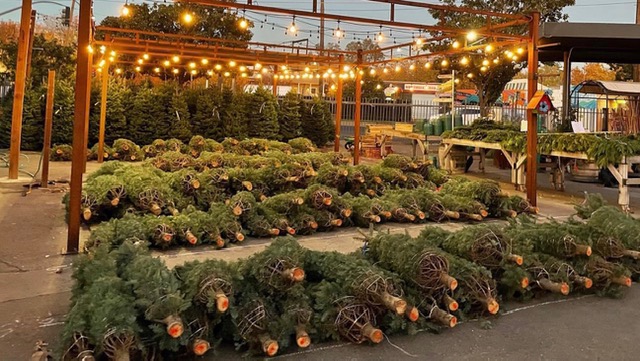
While artificial trees are caught in transit, real trees are ready for customers

|
| Area nurseries and home improvement stores, plus pop-up sellers, will have stock of live Christmas trees. The Plant Foundry, above, in Oak Park received its trees early in the week and the staff members were setting them up as fast as they could. (Photo courtesy The Plant Foundry) |
Will there be a Christmas tree shortage this holiday season? No – if you keep it real.
While artificial trees may be stuck in supply chain snags, real trees should be in good supply, according to the National Christmas Tree Association.
In particular, trees should be in good shape and in good supply from El Dorado County growers. After months of drought, October rain refreshed the pines, firs and cedars. They’re now ready for cutting and customers.
Clustered around Placerville in the Apple Hill area, local growers traditionally open their farms to visitors the day after Thanksgiving and keep selling until sold out. Challenged by drought and pandemic, some family farms have stopped selling trees, but about 20 El Dorado County growers are expected to be offering trees this season. For a map, details and directions, got to https://chooseandcut.com/ .
City shoppers also should find a healthy selection of fresh trees, says the national association, but shop early. The lack of fake tree availability is driving more demand for the real thing.
An intense summer heat wave did sunburn lots of Oregon-grown trees, causing concern, say industry experts. Farms in the northern Willamette Valley reported many heat-related losses. Fortunately, the sunburn was often only cosmetic and could be trimmed off.
Looking for a Christmas tree near you? Check out the tree locator map (and tree tips) at: www.itschristmaskeepitreal.com .
What about a potted living tree? Firs, pines and other conifers are not houseplants; it’s best if these trees’ days indoors are numbered.
If you decide to use a living Christmas tree, keep it outside in a sunny location and well-watered until Christmas week. This reduces stress on the young tree. Make its stay indoors as brief as possible before returning outside – and hopefully finding a spot where it can put its roots down.
Comments
0 comments have been posted.Sacramento Digs Gardening to your inbox.
Food in My Back Yard Series
April 29: What's (already) wrong with my tomato plants?
April 22: Should you stock up on fertilizer? (Yes!)
April 15: Grow culinary herbs in containers
April 8: When to plant summer vegetables
April 1: Don't be fooled by these garden myths
March 25: Fertilizer tips: How to 'feed' your vegetables for healthy growth
March 18: Time to give vegetable seedlings some more space
March 11: Ways to win the fight against weeds
March 4: Potatoes from the garden
Feb. 25: Plant a fruit tree now -- for later
Feb. 18: How to squeeze more food into less space
Feb. 11: When to plant? Consider staggering your transplants
Feb. 4: Starting in seed starting
Sites We Like
Garden Checklist for week of May 4
Enjoy this spring weather – and get gardening!
* Plant, plant, plant! It’s prime planting season in the Sacramento area. Time to set out those tomato transplants along with peppers and eggplants. Pinch off any flowers on new transplants to make them concentrate on establishing roots instead of setting premature fruit.
* Direct-seed melons, cucumbers, summer squash, corn, radishes, pumpkins and annual herbs such as basil.
* Harvest cabbage, lettuce, peas and green onions.
* In the flower garden, direct-seed sunflowers, cosmos, salvia, zinnias, marigolds, celosia and asters. (You also can transplant seedlings for many of the same flowers.)
* Plant dahlia tubers. Other perennials to set out include verbena, coreopsis, coneflower and astilbe.
* Transplant petunias, marigolds and perennial flowers such as astilbe, columbine, coneflowers, coreopsis, dahlias, rudbeckia and verbena.
* Keep an eye out for slugs, snails, earwigs and aphids that want to dine on tender new growth.
* Feed summer bloomers with a balanced fertilizer.
* For continued bloom, cut off spent flowers on roses as well as other flowering plants.
* Add mulch to the garden to maintain moisture. Mulch also cuts down on weeds. But don’t let it mound around the stems or trunks of trees or shrubs. Leave about a 6-inch to 1-foot circle to avoid crown rot or other problems.